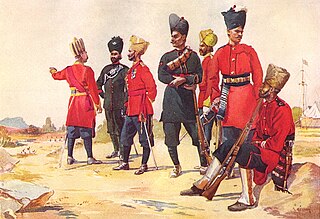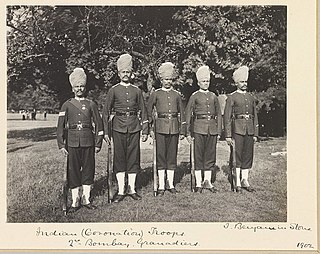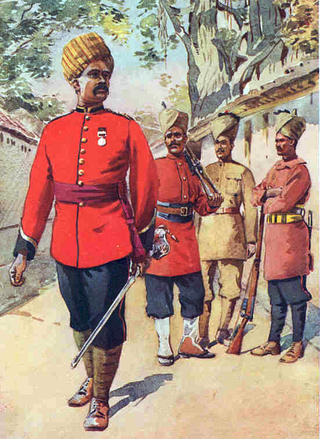Related Research Articles
The 41st Dogras was an infantry regiment of the British Indian Army. The regiment was raised as the 41st (Dogra) Bengal Infantry in 1900 in Jullundur by Major E.T. Gastrell.

The 119th Infantry (The Mooltan Regiment) was an infantry regiment of the British Indian Army. The regiment originated in 1817, when it was raised as the 1st Battalion, 10th Regiment of Bombay Native Infantry.

The 76th Punjabis was an infantry regiment of the British Indian Army. It was raised by Captain Thomas Lane at Trichonopoly on 16 December 1776, as the 16th Carnatic Battalion. It was designated as the 76th Punjabis in 1903 and became the 3rd Battalion 1st Punjab Regiment in 1922. In 1947, it was allocated to the Pakistan Army, where it continues to exist as 3rd Battalion The Punjab Regiment.
The 108th Infantry were an infantry regiment of the British Indian Army. The regiment traces their origins to 1768, when they were raised as the 1st Battalion, Bombay Sepoys.

The 104th Wellesley's Rifles were an infantry regiment of the British Indian Army. They could trace their origins to 1775, when they were raised as the 5th Battalion, Bombay Sepoys and presently its designation is 3 Guards of Indian Army.

The 120th Rajputana Infantry were an infantry regiment of the British Indian Army. The regiment traces their origins to 1817, when they were raised as the 2nd Battalion, 10th Regiment of Bombay Native Infantry.
The 16th Rajputs (The Lucknow Regiment) was an infantry regiment of the Bengal Army and later of the united British Indian Army. It can trace its origins to 1857, during the Indian Mutiny when it was formed from men of the 13th, 48th and 71st Bengal Native Infantry regiments that remained loyal to the British. Named The Lucknow Regiment they were responsible for guarding the Bailey Gate in the Lucknow Residency. Over the years they were known by a number of different titles the 16th Bengal Native Infantry in 1861, the 16th (The Lucknow) Bengal Native Infantry 1864, the 16th (The Lucknow) Bengal Infantry 1885, the 16th (The Lucknow) Rajput Bengal Infantry 1897, the 16th Rajput Infantry (The Lucknow Regiment) 1901 and finally after the Kitchener reforms of the Indian Army the 16th Rajputs (The Lucknow Regiment).
The 18th Infantry were an infantry regiment of the British Indian Army. Their origins trace back to 1795, when they were known as the Calcutta Native Militia. Over the years they were known by a number of different names, such as the Alipore Regiment in 1859, the 18th Bengal Native Infantry in 1861, the 18th (Alipore) Bengal Native Infantry in 1864, the 18th Regiment of Bengal Native Infantry in 1885 and the 18th Musulman Rajput Infantry in 1902. Finally, following the Kitchener reforms of the Indian Army, the 18th Infantry.
The 26th Punjabis were an infantry regiment of the British Indian Army. It was raised in June 1857, as the 18th Regiment of Punjab Infantry. It was designated as the 26th Punjabis in 1903 and became 2nd Battalion of 15th Punjab Regiment Group in 1922. In 1947, it was allocated to the Pakistan Army, where it continues to exist as 10th Battalion The Punjab Regiment.

The 34th Royal Sikh Pioneers was an infantry regiment of the British Indian Army. They could trace their origins to 1857, when they were raised as the Punjab Sappers.
The 37th Dogras was an infantry regiment of the British Indian Army. The regiment could trace its origins to 1887, when it was raised as the 37th (Dogra) Bengal Infantry.

The 102nd Prince of Wales's Own Grenadiers was an infantry regiment of the British Indian Army. It could trace its origins to 1796, when it was raised as the 13th Battalion, Bombay Native Infantry.

The 103rd Mahratta Light Infantry were an infantry regiment of the British Indian Army. They could trace their origins to 1768, when they were raised as the 2nd Battalion, Bombay Sepoys. The regiment was first in action in the Mysore Campaign during the Third Anglo-Mysore War, quickly followed by the Battle of Seedaseer and the Battle of Seringapatam in the Fourth Anglo-Mysore War. Their next action was at Beni Boo Ali against pirates in Eastern Arabia and the Persian Gulf region led the East India Company to carry out a punitive expedition in 1819 to Ras al Khaimah which destroyed the pirate base and removed the threat from the Persian Gulf.

The 107th Pioneers were an infantry regiment of the British Indian Army. Their origin can be traced back to 1788, when they were raised as the 4th Battalion, Bombay Sepoys.

The 110th Mahratta Light Infantry were an infantry regiment of the British Indian Army. The regiment traces their origins to 1797, when they were raised as the 2nd Battalion, 5th (Travancore) Regiment of Bombay Native Infantry.

The 114th Mahrattas were an infantry regiment of the British Indian Army. The regiment traces their origins to 1800, when they were raised as the 2nd Battalion, 7th Regiment of Bombay Native Infantry.

The 116th Mahrattas were an infantry regiment of the British Indian Army. The regiment traces their origins to 1800, when they were raised as the 2nd Battalion, 7th Regiment of Bombay Native Infantry.

The 117th Mahrattas were an infantry regiment of the British Indian Army. The regiment traces their origins to 1800, when they were raised as the Bombay Fencible Regiment.
The 121st Pioneers were an infantry regiment of the East India Company's Bombay Army and later the British Indian Army. The regiment traces their origins to 1777, when they were raised as the Marine Battalion.
The 128th Pioneers were an infantry regiment of the British Indian Army. The regiment traces their origins to 1846, when they were raised as the 28th Bombay Native Infantry.
References
- 1 2 3 4 Spackman, Col. W.C. (2008). Captured at Kut : prisoner of the Turks : the Great War diaries of Colonel W.C. Spackman. ISBN 9781844158737.
- ↑ Perry, F.W. (1993). History of the Great War: Order of Battle of Divisions: Indian Army Divisions Pt. 5B. Ray Westlake Books. ISBN 1-871167-23-X
- ↑ Sumner p.15
- ↑ Griffen, Charles. "48th Pioneers" . Retrieved 21 February 2023.
- Barthorp, Michael; Burn, Jeffrey (1979). Indian infantry regiments 1860-1914. Osprey Publishing. ISBN 0-85045-307-0.
- Sumner, Ian (2001). The Indian Army 1914-1947. Osprey Publishing. ISBN 1-84176-196-6.